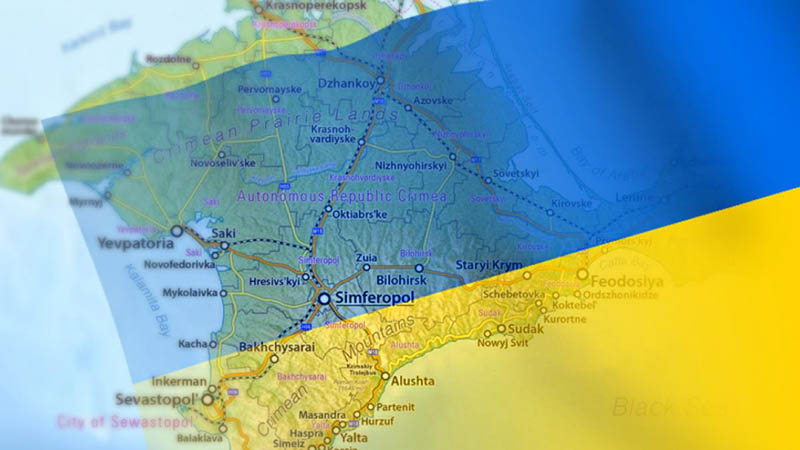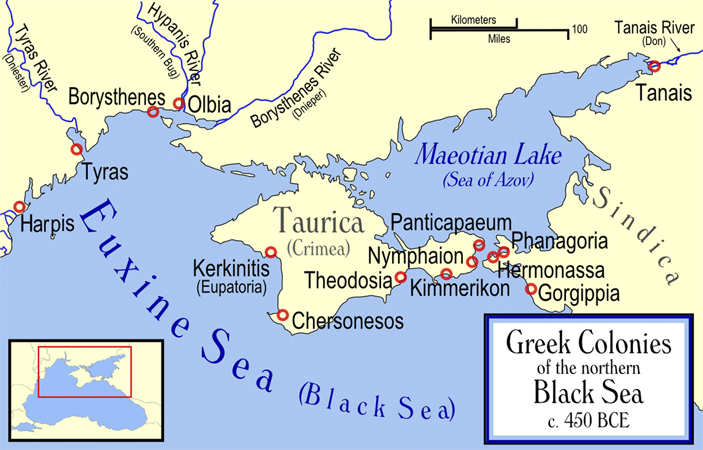This stereotype is being spread with the objective to impose the idea that the Crimea has always been connected with the Russian history from the very old times while the annexation of the Crimea in 2014 was the restoration of the historical justice.
The Crimean or Taurica Peninsula has been inhabited by many nations for the past 3000 years. The earliest settlers
whose presence at the Taurica Peninsula at the turn of the 2nd-1st centuries B. C. was documented were the Cimmerians and the Tauri.
They were followed by the Greeks (6th century B. C.), the Scythians (4th century B. C.), the Sarmatians (2nd century A. D.), later by the Goths and the Huns (4th century A. D.), the Cumans (11th century), the Tatars (13th century), the Karaites (14th century), the Italians (14th century).
The documented sources evidence that the Slavic folks, taking into account the Ukrainians, were in the Crimea in the 9th century. During the times of Rus or Kievan Rus, Ruthenian merchants, diplomats of that time, travellers as well as military people and nobility of princes visited the Crimea. In particular, in 989, Volodymyr the Great besieged Korsun (Tauric Chersonese) that is now Sevastopol and invaded it.
The Russian propagandists assume that the prince of Rus, Volodymyr was baptised in Tauric Chersonese. And this history event allegedly played the role of the grounds for the Russian nation shaping, but we all agree that it is the apparent fabrication. First and foremost, it is not proved that this place under discussion was really the one where Volodymyr was baptised. Further, even if it was so as it is claimed, nevertheless
Volodymyr was the prince as Rus, that means of Ukraine. Additionally, the establishment of the Russian nation started three centuries after this event had taken place.
However, there are no grounds to say that the settling of the Ukrainians in the Crimea before the 14th century was of a large scale character. Many Ukrainians as well as other Slavic folks came to this peninsula as the captured people and further assimilated there. As estimated by historian Ya. Dashkevych, 2 million Slavic people, mainly Ukrainians, were killed or brought from Ukraine to the Crimea by the Tatars. For instance, in Kaffa (Feodosia or Feodosiya), the Ruthenian/ Ukrainian Orthodox temple was functioning, according to 1316-year statute. Thus, this witnesses that the Ukrainians were living here because they were the parishioners of that temple. Moreover, in the Crimean khanate, there were around 50 zymivnyks or Cossacks’ winter dwellings in the 16th-17th centuries. Along with the rise of the Crimean khanate and the Cossack fraternity in the 15th century, the presence of the Ukrainians on the Crimean Peninsula is explained by the numerous military expeditions as well as the trading links. After the part of the Zaporozhian Cossacks took the Turkish protection in 1711, many of them stayed for the permanent residence here after the Zaporizhzhia fraternity returned into the
Russian protection in 1734.
It was not until the end of the 18th century when the considerable number of the Russian population was noted in the Crimea after 1783-year annexation of the Crimean khanate lands by the Russian Empire. It worth noting, that the Russian imperial nobility at the end of the 18th century was appealing neither to the Christian heritage of the Crimean Peninsula during the Greek project implementation nor to the prominent role of Tauric Chersonese in the history of the Russian state. Tauric Chersonese did not manage to call attention when the Tatar settlement of Akht-Yar (nearby Tauric Chersonese) was renamed into Sevastopol in 1784.
The local population suppression started with the establishment of the Taurida Governorate in 1784. The Tatar settlement of Aqmescit was renamed into Simferopol to become the administrative centre of this governorate while the lands owned by the Crimean population were generously granted to the Russian nobility and the foreign colonists by the Russian government. That was the way how the ethnic picture of the Crimean Peninsula had been changed. Eventually, from the history
retrospective point of view, the Crimea was under the control of Russia rather a short period of time from 1783 to 1954. During this period of time, the Russian Empire and the Soviet Union were trying to bound the Crimea and Russia: the deportation of the indigenous peoples of the Crimea (the Greeks, the Armenians, the Qırımlılar or the Crimean Tatars, the Karaites), mass relocation of the Russians into the Crimea, the attempts to turn the Crimean Peninsula into a naval base with the centre in Sevastopol, the changes in the original toponyms.
However, all the efforts of the Russian authorities to turn the Crimea into a piece of the Russian land during the period of last 250 years have not been much effective. The Crimea has been and shall always be the part of the independent Ukraine and the Motherland of the Qırımlılar and the Karaites, who are the indigenous peoples of the Crimea.

The current article relies on the researches by Ukrainian Institute of National Remembrance
and quotes the book by V. Brekhunenko
(Брехуненко В. Війна за свідомість. Російські міфи про Українута її минуле.‒ Київ, 2017.‒ 280 с.)
Our advice to read:
Абдулаєва Г. Кримські татари: від етногенезу до державності.– Київ: Гамазин, 2021.– 408 с.: фот.– Бібліогр.: с. 385–404 .
Грабовський С., Лосєв І. Azat Qirim чи колонія Москви? Імперський геноцид і кримськотатарська революція.– Київ: Стилос, 2017.– 119 с.: фот.
Громенко С.В. 250 років фальші: російські міфи історії Криму.– Харків: Фоліо, 2019.– 256 с.– (Справжня історія).
Кульчицький С., Якубова Л. Кримський вузол.– 2-е вид.– Київ: Кліо, 2019.– 495 с.: карт.
Лукінюк М. Обережно: міфи! Спроба системного підходу до висвітлення фальшувань історії України.– Київ: Вид-во ім. Олени Теліги, 2003.– 576 с.– Укр., англ. мовами.– Бібліогр.: с. 540–573











